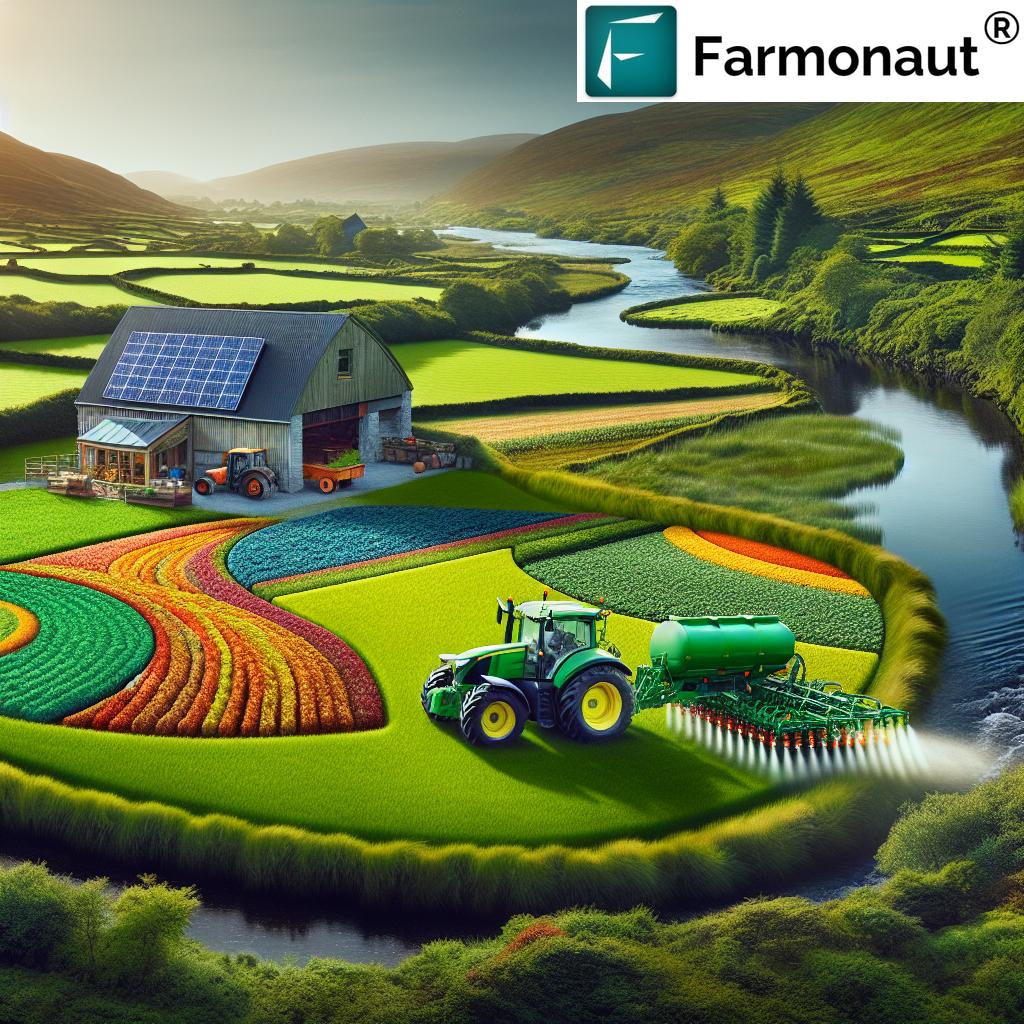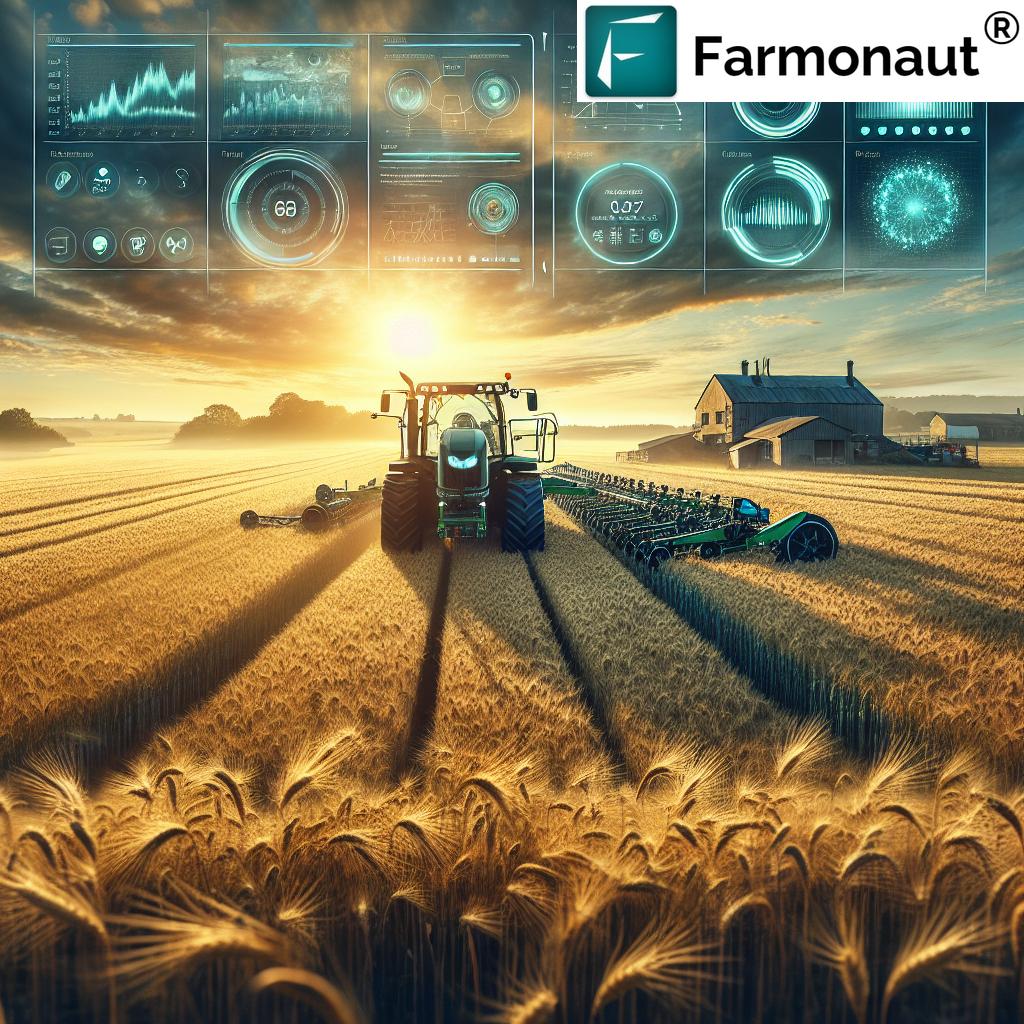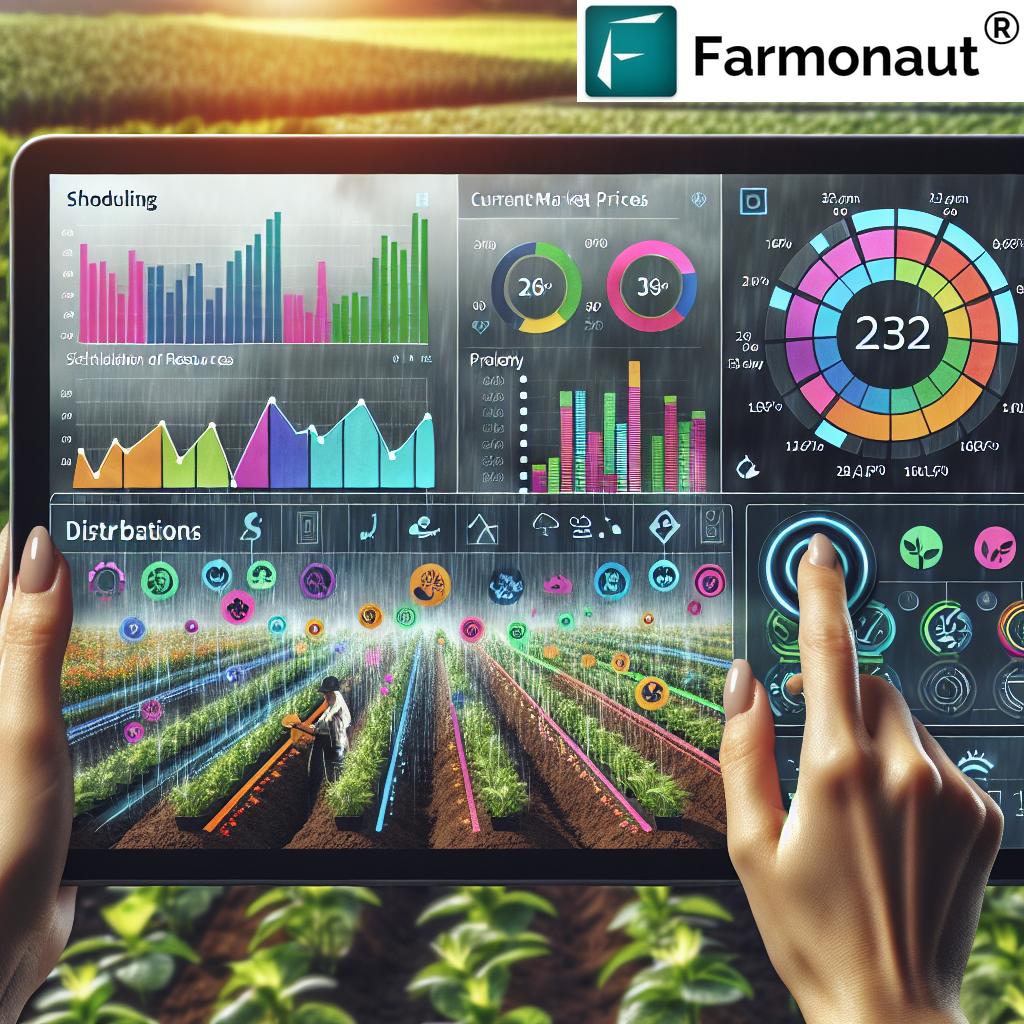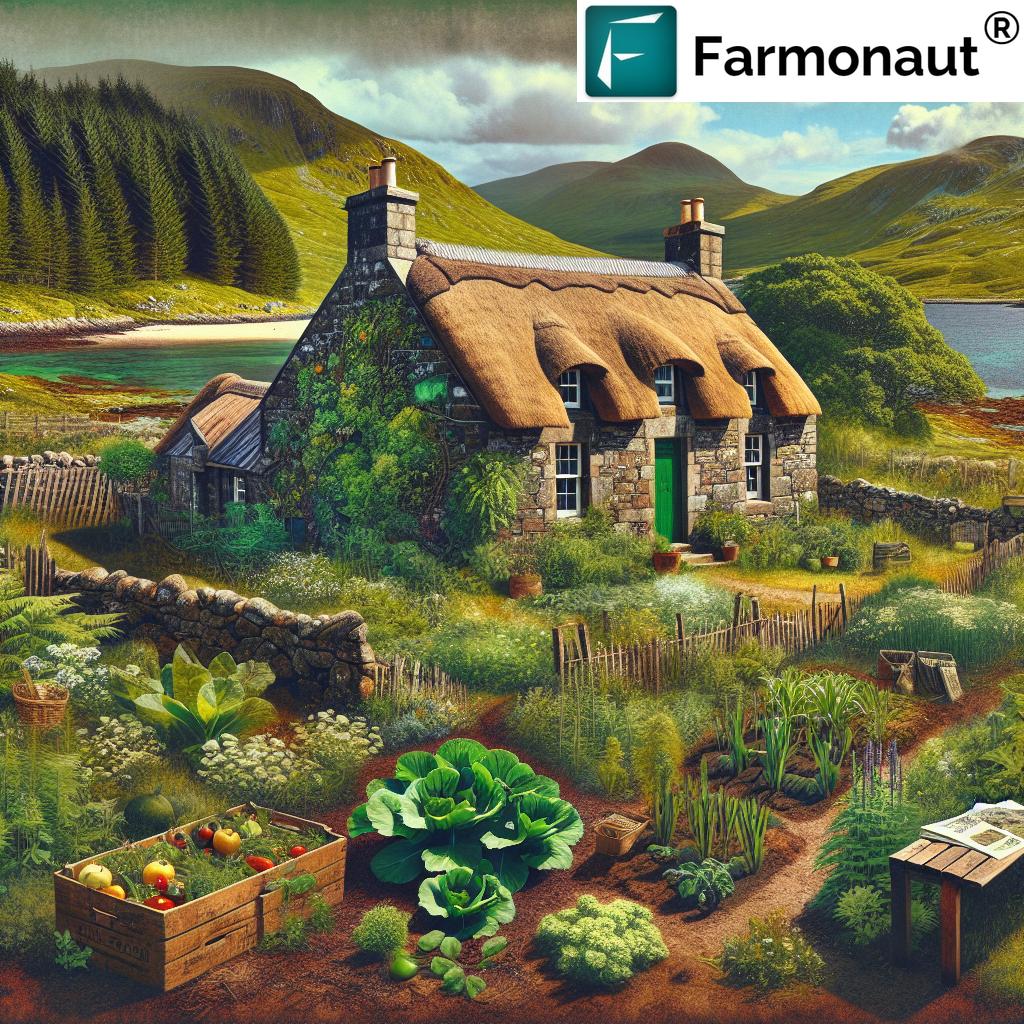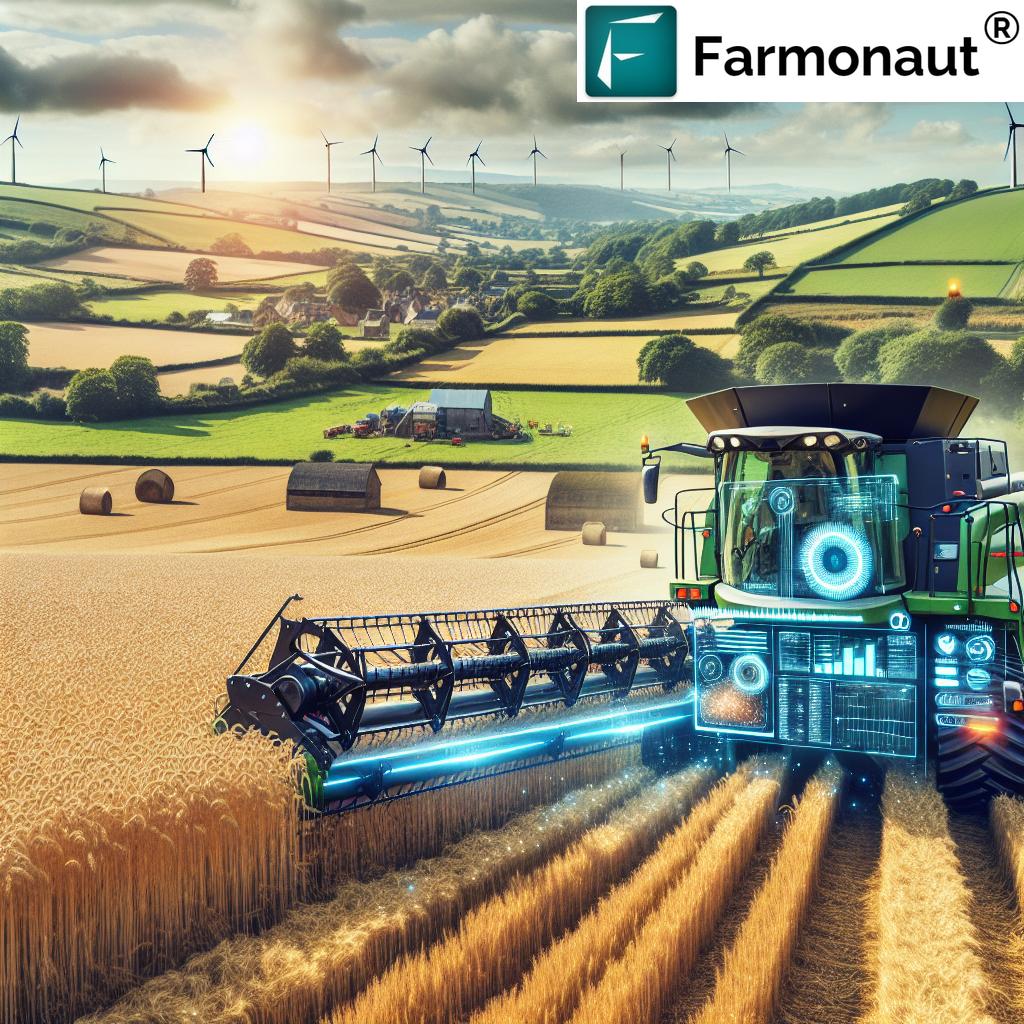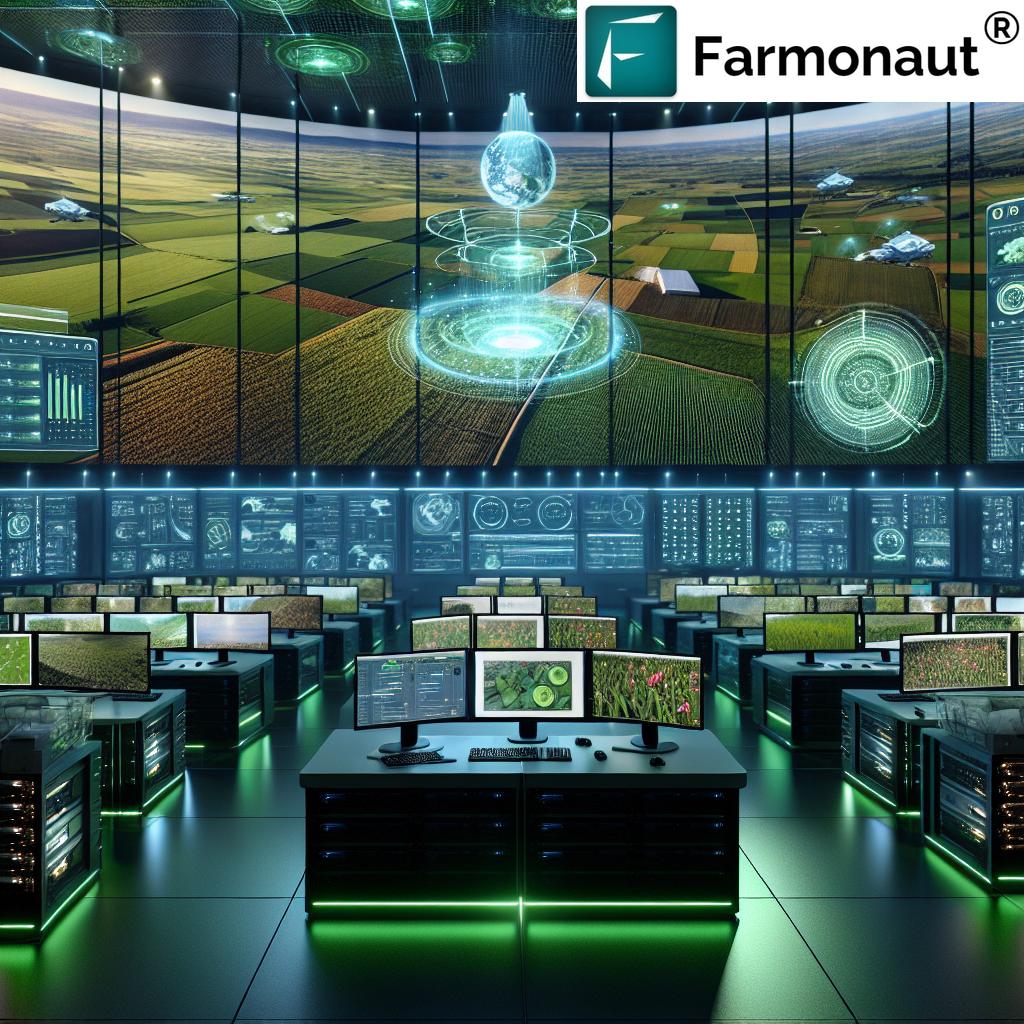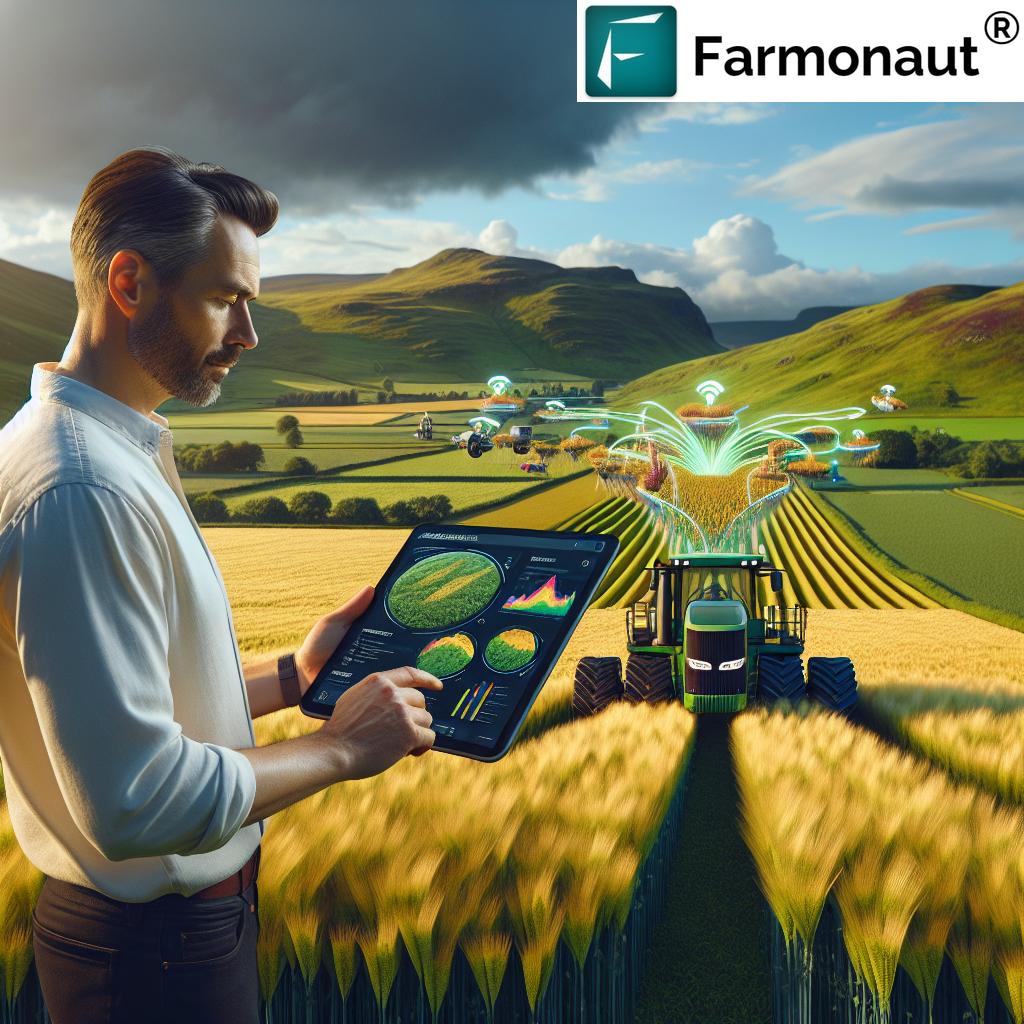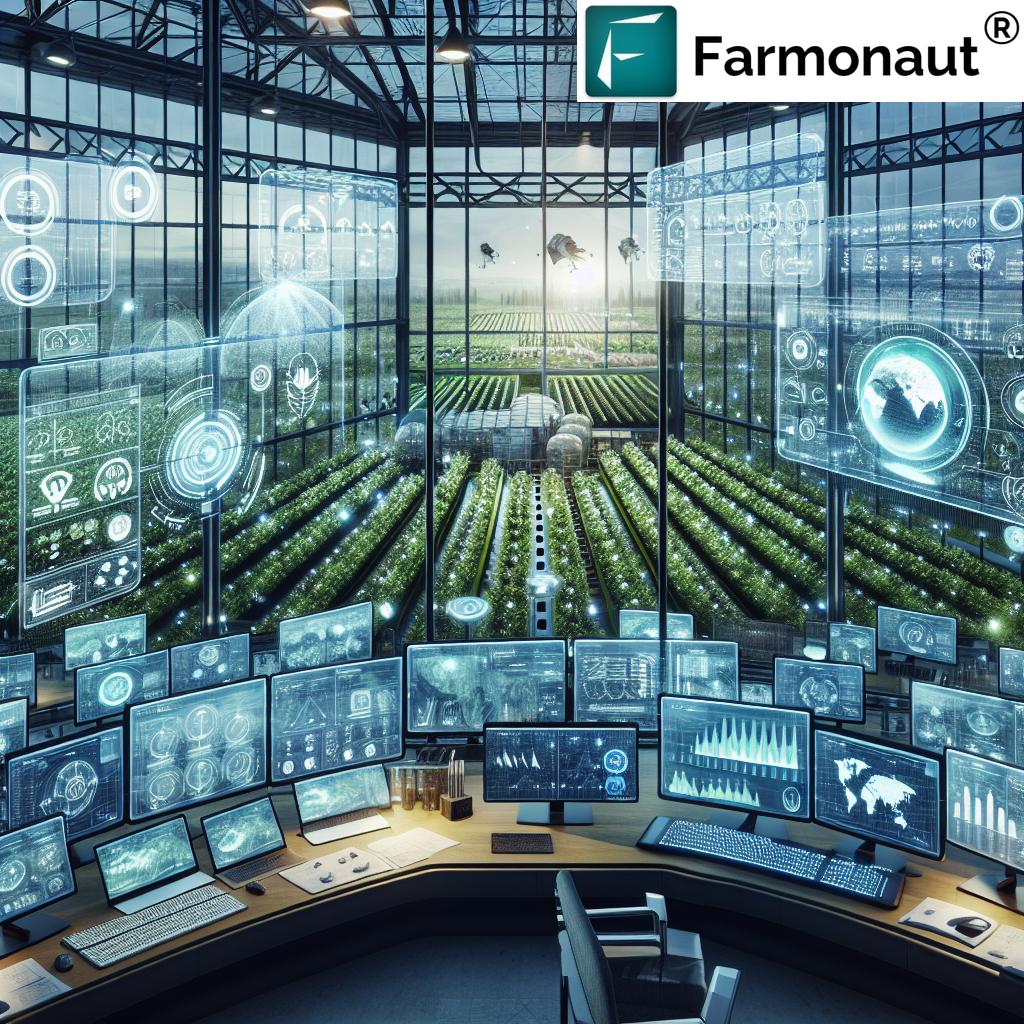Revolutionizing Agriculture: How Digital Farming Tools and Precision Technology Are Transforming England’s Farms
“Precision agriculture technology has increased crop yields by up to 15% on English farms implementing smart farming solutions.”
In the rolling hills and fertile plains of England and Wales, a quiet revolution is taking place. The age-old practice of farming is undergoing a dramatic transformation, driven by the relentless march of technology and the urgent need for sustainable agricultural practices. We’re witnessing the dawn of a new era in farming, where digital tools and precision technology are reshaping the landscape of agriculture, quite literally from the ground up.
As we delve into this exciting frontier, we’ll explore how precision agriculture technology is not just a buzzword, but a tangible reality that’s changing the way farmers work, crops grow, and livestock thrive. From the bustling dairy farms of the Midlands to the sprawling arable enterprises of East Anglia, smart farming solutions are taking root, promising a future where efficiency and sustainability go hand in hand.
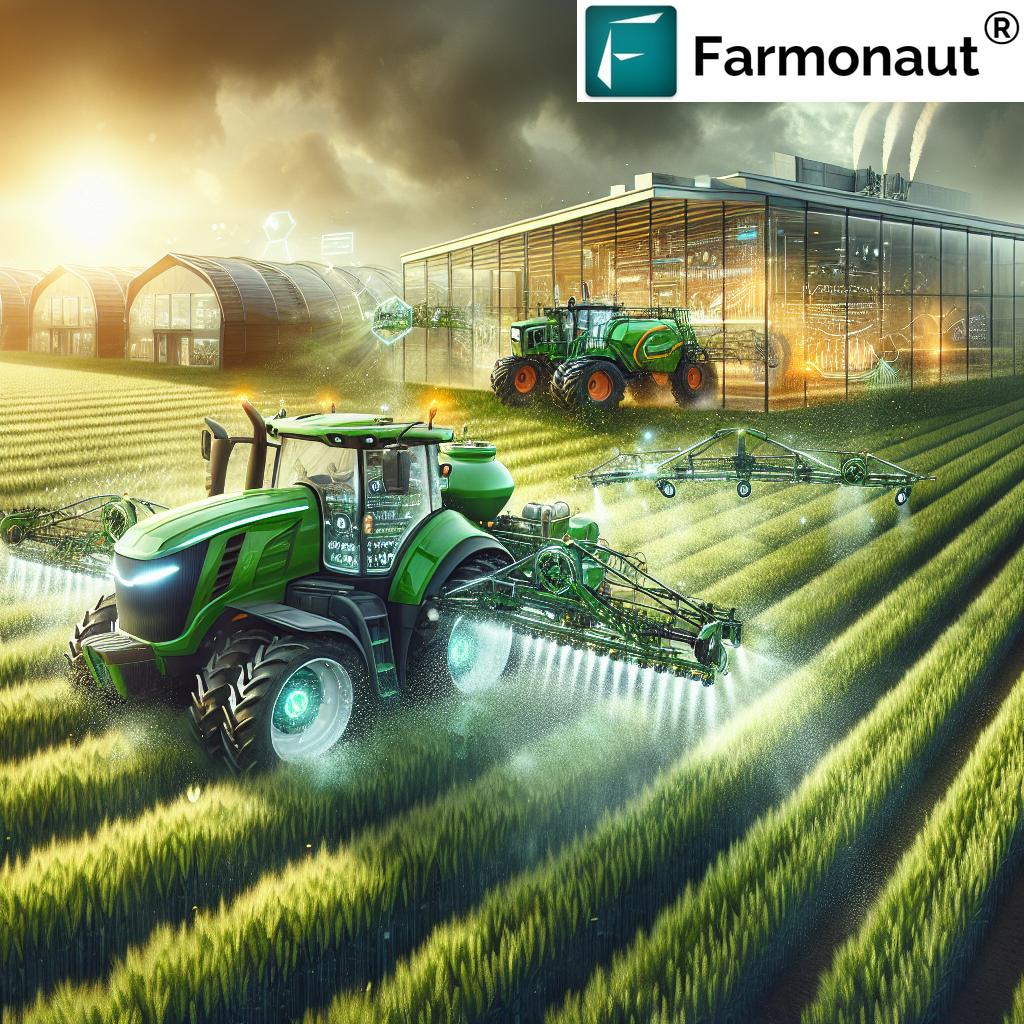
The Digital Revolution in England’s Farmlands
Gone are the days when farming was solely dependent on traditional knowledge passed down through generations. Today, England’s farmers are embracing a suite of digital farming tools that are revolutionizing every aspect of agriculture. From crop yield optimization to efficient farm management, these technologies are proving to be game-changers in an industry that’s facing increasing pressure to feed a growing population while reducing its environmental footprint.
Let’s take a closer look at some of the key technologies that are transforming England’s farms:
- Satellite-based monitoring: Companies like Farmonaut are leveraging satellite imagery to provide real-time insights into crop health, soil moisture levels, and more. This technology allows farmers to make data-driven decisions about irrigation, fertilizer application, and pest management.
- IoT sensors: Smart sensors deployed across fields are collecting vast amounts of data on soil conditions, weather patterns, and crop growth. This information feeds into sophisticated farm management software, enabling precise control over farming operations.
- Agricultural drones: These eyes in the sky are revolutionizing field surveys, crop spraying, and even livestock monitoring. Agricultural drone applications are becoming increasingly sophisticated, offering farmers unprecedented views of their land.
- Automated farm equipment: From self-driving tractors to robotic milking systems, farm equipment automation is reducing labor costs and increasing efficiency across both arable and livestock enterprises.
As we continue to explore these technologies, it’s important to note that their adoption is not just a matter of convenience but a necessity for the future of farming in England and Wales. The challenges of climate change, resource scarcity, and economic pressures are driving farmers to seek out these smart farming solutions as a means of survival and growth in an increasingly competitive global market.
Precision Agriculture: A Data-Driven Approach to Farming
At the heart of this agricultural revolution lies the concept of precision agriculture. This approach uses agricultural data analytics to make farming more accurate and controlled when it comes to growing crops and raising livestock. By leveraging data from various sources, farmers can make informed decisions that optimize their operations and improve yields.
Here’s how precision agriculture is making a difference:
- Variable rate technology: This allows farmers to apply different amounts of inputs like water, fertilizer, or pesticides to specific areas of a field based on plant needs and soil conditions.
- Yield mapping: By collecting data during harvest, farmers can create detailed maps showing the productivity of different areas within a field, informing future planting decisions.
- Livestock monitoring systems: Advanced sensors and wearable technology for animals provide real-time data on health, location, and productivity, revolutionizing livestock management.
The impact of these technologies on England’s farms has been significant. For instance, some arable farms have reported up to 20% reduction in fertilizer use while maintaining or even increasing yields. In the dairy sector, automated milking systems have not only improved milk yields but also enhanced animal welfare by allowing cows to be milked on their own schedule.

The Role of Farm Management Software
“Over 60% of large-scale farms in England now use farm management software for optimizing operations and data analytics.”
Central to the implementation of precision agriculture is the use of sophisticated farm management software. These platforms serve as the brain of the operation, integrating data from various sources to provide farmers with actionable insights. From planning crop rotations to managing livestock records, farm management software is becoming an indispensable tool for modern farmers.
Key features of modern farm management software include:
- Real-time monitoring of field conditions and crop health
- Integration with weather forecasts for better planning
- Financial management tools for budgeting and profit analysis
- Inventory management for seeds, fertilizers, and other inputs
- Compliance tracking for environmental regulations
One such innovative platform is offered by Farmonaut, which provides satellite-based farm management solutions. Their technology allows farmers to monitor crop health, receive AI-driven advisory services, and even track their carbon footprint. This level of insight is transforming how farmers approach their day-to-day operations, leading to more sustainable and profitable farming practices.
To explore Farmonaut’s cutting-edge solutions, check out their web app or download their mobile apps:
Transforming Livestock Management with Digital Tools
While much attention is given to crop farming when discussing precision agriculture, the livestock sector is also benefiting greatly from these technological advancements. Livestock monitoring systems are revolutionizing how farmers manage their herds, from cattle and sheep to poultry.
Here’s how digital tools are improving livestock farming:
- Health tracking: Wearable devices for animals can monitor vital signs and activity levels, alerting farmers to potential health issues before they become serious.
- Automated feeding systems: Smart feeders can dispense precise amounts of feed based on individual animal needs, optimizing nutrition and reducing waste.
- Behavior analysis: AI-powered cameras can monitor animal behavior, helping to identify signs of distress or illness early on.
- Breeding management: Advanced software helps farmers track breeding cycles and genetic information, leading to improved herd quality over time.
For poultry farmers, these technologies are particularly crucial in managing large flocks efficiently. Automated systems can control temperature, humidity, and ventilation in poultry houses, creating optimal conditions for bird health and egg production. This level of precision not only improves welfare but also helps in preventing outbreaks of diseases like avian influenza, which has been a significant concern for the industry.
The Impact of Precision Agriculture on Arable Enterprises
For arable farms across England and Wales, precision agriculture technologies are proving to be transformative. The ability to manage large tracts of land with pinpoint accuracy is not just improving yields but also contributing to more sustainable farming practices.
Key technologies impacting arable farming include:
- GPS-guided machinery: Tractors and other farm equipment equipped with GPS can operate with centimeter-level accuracy, reducing overlap and improving efficiency in planting, spraying, and harvesting.
- Soil sampling and mapping: Detailed soil analysis allows farmers to create precise fertility maps, enabling variable rate application of fertilizers and other inputs.
- Crop sensors: Advanced sensors can detect crop health issues, nutrient deficiencies, and pest infestations in real-time, allowing for targeted interventions.
- Predictive analytics: By analyzing historical data and current conditions, farmers can make more accurate predictions about yield potential and optimize their crop management strategies.
These technologies are not just improving productivity; they’re also helping farmers to be better stewards of the land. By applying inputs more precisely, farmers can reduce waste and minimize environmental impact, aligning with the growing emphasis on sustainable farming practices.
Grassland Management and Precision Agriculture
The benefits of precision agriculture extend beyond arable lands to grassland management, which is crucial for livestock farming in England and Wales. Digital tools are helping farmers optimize pasture utilization, leading to improved grazing efficiency and better quality forage.
Innovative approaches in grassland management include:
- Satellite imagery for pasture assessment: Regular satellite imagery can help farmers track pasture growth rates and quality, informing rotational grazing decisions.
- Smart electric fencing: GPS-enabled fencing systems allow for precise control over grazing areas, ensuring optimal pasture utilization.
- Drone surveys: Drones equipped with multispectral cameras can assess pasture health and identify areas that may need reseeding or fertilization.
- IoT sensors for soil moisture: These sensors help farmers make informed decisions about irrigation, particularly important in areas prone to drought.
By leveraging these technologies, livestock farmers can significantly improve the productivity of their grasslands, leading to better feed quality for their animals and reduced reliance on purchased feeds.
The Future of Farming: Sustainable and Data-Driven
As we look to the future of farming in England and Wales, it’s clear that the integration of digital tools and precision technologies will play a crucial role in addressing the challenges of food security, climate change, and environmental sustainability.
Some key trends to watch include:
- AI and machine learning: These technologies will become increasingly sophisticated, offering even more accurate predictions and recommendations for farm management.
- Blockchain in agriculture: Improving traceability and transparency in the food supply chain, from farm to fork.
- Vertical farming: While not traditional, this technology is gaining traction, especially near urban areas, and could complement traditional farming methods.
- Robotics: From autonomous tractors to robotic harvesters, the role of robotics in farming is set to expand significantly.
The adoption of these technologies is not without challenges. Issues such as data privacy, the digital divide between large and small farms, and the need for specialized training all need to be addressed. However, the potential benefits in terms of increased productivity, reduced environmental impact, and improved farm profitability make the pursuit of these innovations worthwhile.
Government Initiatives and Support for Agricultural Innovation
The UK government recognizes the importance of supporting the agricultural sector in its transition to more technologically advanced and sustainable practices. Various initiatives and funding programs have been put in place to encourage the adoption of precision agriculture technologies.
Key government support measures include:
- Grants for technology adoption: Schemes that provide financial support for farmers looking to invest in precision agriculture equipment and software.
- Research funding: Investment in agricultural research institutions to develop new technologies tailored to the UK farming context.
- Knowledge transfer partnerships: Programs that connect farmers with academic institutions and technology companies to foster innovation.
- Digital skills training: Initiatives to improve digital literacy among farmers, ensuring they can make the most of new technologies.
These efforts are crucial in ensuring that farms of all sizes can benefit from the digital revolution in agriculture, helping to create a more resilient and competitive farming sector across England and Wales.
Precision Agriculture Technologies and Their Impact on English Farms
| Technology | Primary Application | Estimated Adoption Rate | Potential Yield Increase |
|---|---|---|---|
| Agricultural Drones | Field mapping, crop spraying, livestock monitoring | 30-40% | 5-10% |
| IoT Sensors | Soil and crop monitoring, weather data collection | 40-50% | 10-15% |
| Automated Farm Equipment | Precision planting, harvesting, and fertilizer application | 20-30% | 8-12% |
| Livestock Monitoring Systems | Health tracking, automated feeding, behavior analysis | 35-45% | 15-20% (in productivity) |
| Farm Management Software | Data analytics, resource planning, financial management | 60-70% | 10-15% (in overall efficiency) |
Challenges and Considerations
While the benefits of precision agriculture are clear, there are several challenges that farmers and the industry as a whole must navigate:
- Initial investment costs: Many precision agriculture technologies require significant upfront investment, which can be a barrier for smaller farms.
- Data management and privacy: With the increase in data collection, ensuring data security and privacy becomes crucial.
- Skill gap: The adoption of new technologies requires farmers and farm workers to develop new skills and knowledge.
- Connectivity issues: Many rural areas still lack reliable high-speed internet, which is essential for many digital farming tools.
- Integration of different systems: Ensuring that various technologies and software can work together seamlessly can be challenging.
Addressing these challenges will be key to the widespread adoption and success of precision agriculture technologies across England and Wales.
Conclusion: Embracing the Digital Future of Farming
As we’ve explored throughout this article, the integration of digital farming tools and precision technologies is not just reshaping agriculture in England and Wales – it’s revolutionizing it. From the rolling hills of the countryside to the fertile plains, farmers are increasingly turning to smart farming solutions to overcome challenges, improve productivity, and ensure sustainability.
The adoption of precision agriculture technology, farm management software, and advanced monitoring systems is enabling farmers to make data-driven decisions, optimize resource use, and reduce environmental impact. As these technologies continue to evolve and become more accessible, we can expect to see even greater transformations in how we produce food and manage our agricultural landscapes.
For farmers looking to stay competitive in an ever-changing agricultural landscape, embracing these digital tools is no longer optional – it’s essential. The future of farming in England and Wales is digital, data-driven, and more sustainable than ever before. By harnessing the power of technology, farmers can not only meet the challenges of today but also prepare for the opportunities of tomorrow.
As we conclude, it’s clear that the agricultural revolution brought about by digital farming tools and precision technology is just beginning. The farms of England and Wales are at the forefront of this exciting transformation, leading the way towards a more efficient, productive, and sustainable future for agriculture.
FAQ Section
Q: What is precision agriculture?
A: Precision agriculture is a farming management concept that uses digital technologies to monitor and optimize agricultural production processes. It involves the use of GPS, sensors, robotics, and data analytics to improve crop yields and reduce resource waste.
Q: How does farm management software benefit farmers?
A: Farm management software helps farmers by centralizing data, automating tasks, providing real-time insights, and enabling better decision-making. It can assist with everything from crop planning and inventory management to financial tracking and compliance reporting.
Q: Are these technologies affordable for small farms?
A: While some technologies require significant investment, many solutions are becoming more affordable and accessible to small farms. Cloud-based services and mobile apps, for instance, often offer scalable solutions that can be cost-effective for smaller operations.
Q: How does precision agriculture contribute to sustainability?
A: Precision agriculture promotes sustainability by optimizing resource use, reducing chemical inputs, minimizing soil compaction, and improving overall farm efficiency. This leads to reduced environmental impact and more sustainable farming practices.
Q: What role do drones play in modern farming?
A: Drones are used in agriculture for various purposes, including crop monitoring, soil and field analysis, planting, crop spraying, and irrigation management. They provide farmers with a bird’s-eye view of their fields, helping to identify issues quickly and efficiently.







